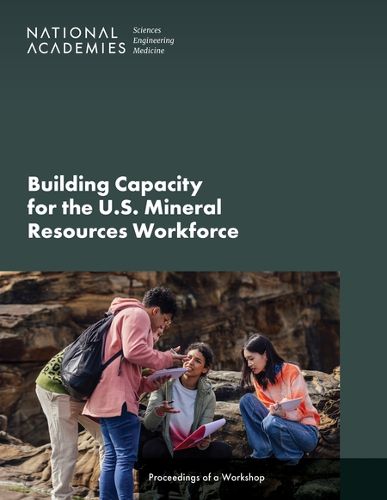Readings Newsletter
Become a Readings Member to make your shopping experience even easier.
Sign in or sign up for free!
You’re not far away from qualifying for FREE standard shipping within Australia
You’ve qualified for FREE standard shipping within Australia
The cart is loading…






The extraction of mineral resources provides the raw materials necessary to produce the products and technologies on which the global economy depends, including green technologies essential for decarbonization. Mineral extraction requires expertise in a range of areas - including mineral resources identification, environmental evaluation, processing, and reclamation - but many of the U.S. academic programs that have historically educated the U.S. minerals workforce face significant challenges attracting students and maintaining financial viability. For some programs, enrollment dropped 60 percent from 2015 to 2023, despite a growing demand for a minerals workforce.
The National Academies convened a workshop on January 23-24, 2024 to consider how the United States can build the capacity of federal and state agencies, academia, and the private sector to meet U.S. mineral workforce needs. Participants addressed the urgent need to attract more students, discussed a need to integrate new disciplines into curricula as the industry evolves, and identified multipronged approaches to help enhance overall retention and recruitment. This proceedings synthesizes the key suggestions presented by participants that universities, companies, and government agencies could take to enhance the recruitment, training, and retention of workers in the mineral resources industry.
Table of Contents
Front Matter 1 Overview 2 Introduction and Context 3 Growing Mineral Resources Programs at Universities 4 Disciplines and Skills for a Future Mineral Resources Workforce 5 Supporting Students and Faculty Through Research Funding and AcademiaAgencyIndustry Partnerships 6 Preparing Students Through Internships, Professional Development, and Mentorship 7 Growing Interest Among University and 12th-Grade Students 8 Improving Retention in the Mineral Resources Workforce 9 Reflections References Appendix A: Workshop Planning Committee Member Biographies Appendix B: Statement of Task Appendix C: Workshop Agenda
$9.00 standard shipping within Australia
FREE standard shipping within Australia for orders over $100.00
Express & International shipping calculated at checkout
The extraction of mineral resources provides the raw materials necessary to produce the products and technologies on which the global economy depends, including green technologies essential for decarbonization. Mineral extraction requires expertise in a range of areas - including mineral resources identification, environmental evaluation, processing, and reclamation - but many of the U.S. academic programs that have historically educated the U.S. minerals workforce face significant challenges attracting students and maintaining financial viability. For some programs, enrollment dropped 60 percent from 2015 to 2023, despite a growing demand for a minerals workforce.
The National Academies convened a workshop on January 23-24, 2024 to consider how the United States can build the capacity of federal and state agencies, academia, and the private sector to meet U.S. mineral workforce needs. Participants addressed the urgent need to attract more students, discussed a need to integrate new disciplines into curricula as the industry evolves, and identified multipronged approaches to help enhance overall retention and recruitment. This proceedings synthesizes the key suggestions presented by participants that universities, companies, and government agencies could take to enhance the recruitment, training, and retention of workers in the mineral resources industry.
Table of Contents
Front Matter 1 Overview 2 Introduction and Context 3 Growing Mineral Resources Programs at Universities 4 Disciplines and Skills for a Future Mineral Resources Workforce 5 Supporting Students and Faculty Through Research Funding and AcademiaAgencyIndustry Partnerships 6 Preparing Students Through Internships, Professional Development, and Mentorship 7 Growing Interest Among University and 12th-Grade Students 8 Improving Retention in the Mineral Resources Workforce 9 Reflections References Appendix A: Workshop Planning Committee Member Biographies Appendix B: Statement of Task Appendix C: Workshop Agenda